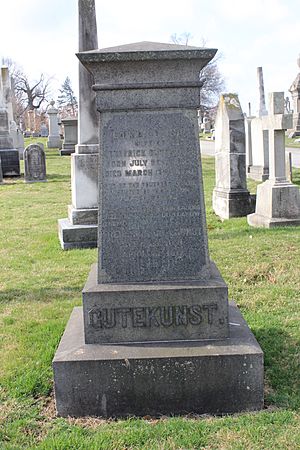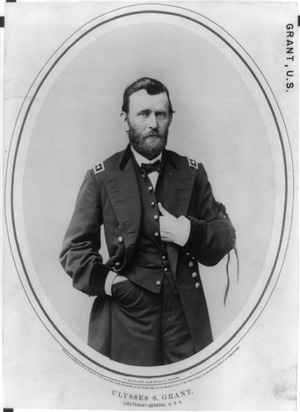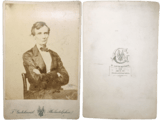Frederick Gutekunst facts for kids
Quick facts for kids
Frederick Gutekunst
|
|
|---|---|
 |
|
| Born | September 25, 1831 |
| Died | April 27, 1917 (aged 85) Philadelphia, Pennsylvania, US
|
| Resting place | Laurel Hill Cemetery |
| Occupation | Photographer |
Frederick Gutekunst (born September 25, 1831 – died April 27, 1917) was a famous American photographer from Philadelphia, Pennsylvania. He opened his first photo studio with his brother in 1854 and ran his business for 60 years! He became very well known during the American Civil War and grew his business to include two studios and a big printing factory for photos. People called him the "Dean of American Photographers" because he took amazing pictures of important people and famous stars. He was the official photographer for the Pennsylvania Railroad. He also became famous around the world for his photos of the Gettysburg battlefield and a super long, 10-foot wide panoramic photo of the Centennial Exposition.
Contents
Early Life and Learning
Frederick Gutekunst was born in 1831. His dad was a cabinetmaker. The family name "Gutekunst" means "good art" in German. Most people say he was born in Philadelphia. But, his obituary (a notice about someone's death) said he was born in Germany.
His father wanted Frederick to become a lawyer. So, he sent him to study law for six years. But Frederick found studying law "dry and uninteresting." Instead, he became very interested in a new photography method called the daguerreotype. He often visited a photo gallery owned by Marcus Aurelius Root. He learned how to make daguerreotypes from a photography pioneer named Robert Cornelius. Frederick was good at chemistry. He even figured out how to turn a daguerreotype into a printable plate.
Frederick's father noticed his son's interest in chemistry. He found an internship for him with a pharmacist named Frederick Klett. Frederick worked with Klett for four years. He then graduated from the Philadelphia College of Pharmacy in 1853.
Photography Career
After college, Frederick worked at a drug store in Philadelphia for two years. During this time, he started collecting parts to build his own camera. He bought a lens and a battery, and his father built the camera's box. He joined the Franklin Institute and used their labs to do science experiments. He made his own photographic plates using a special liquid called collodion. He took ambrotypes (a type of photo) of his friends in the back of the drug store.
Frederick's brother, Louis, was a barber. He helped Frederick pay for his photography hobby. In 1856, the two brothers opened a photography studio called Gutekunst & Brother. They worked together until 1860, when Louis went back to being a barber.
Growing Famous During the Civil War
The photo business grew quickly because many people wanted pictures. The American Civil War made Gutekunst's studio super popular. Philadelphia was a major place where soldiers gathered before going to war. Soldiers would get their portraits taken in their uniforms. These photos were keepsakes for their families before they left.
Important generals like George Meade, Ulysses S. Grant, and Philip Sheridan also came to Gutekunst for their photos. His portrait of General Grant became very famous across the country. This photo helped Gutekunst stand out from other photographers.
Famous People and Big Projects
Gutekunst took pictures of many important people and celebrities. These included Caroline Still Anderson, William Cullen Bryant, Grover Cleveland, William Lloyd Garrison, Abraham Lincoln, Henry Wadsworth Longfellow, William McKinley, Carl Schurz, and Walt Whitman. He kept detailed lists of everyone he photographed. One of these lists is kept at the Library Company of Philadelphia.
He became the official photographer for the Pennsylvania Railroad. In 1875, he photographed railroad buildings and beautiful scenery. These photos were printed as a collection of stereo views (pictures that look 3D).
Gutekunst became known as the "Dean of American Photography." He was also famous for his photos of the Battle of Gettysburg battlefield. In 1876, he created a huge panoramic photo of the Centennial Exposition. This photo was ten feet wide and 18 inches tall! He made it from seven different negatives. At the time, it was called the largest photograph in the world. His panoramic photo won him medals from Austria, France, and Italy. He also received two fancy bronze vases from Japan.
New Printing Methods
Gutekunst was both an artist and a smart businessman. In 1878, he visited Germany and bought the rights to use a special printing process called Phototype. One year later, an editor from a photography magazine visited Philadelphia. He noted that Gutekunst was making thousands of prints every day!
Eventually, this new printing factory needed a bigger space. It moved to 813 Girard Ave. There, a team of 40 people worked under the manager, James P. Harbeson. They kept up with the high demand for photo reproductions for books and magazines. Girard Ave was a great spot for this factory because it was more industrial than his Arch Street location.
His factory produced illustrations for books like Biographical Album of Prominent Pennsylvanians. He also made pictures for Artistic Houses and Artistic Country Seats. These books were published by D. Appleton & Co. of New York. Gutekunst also started using what we now call a panoramic camera. This camera could take a 180-degree photo. From these, his studio could make prints that were 36 inches long!
In 1885, he was chosen to be a member of the American Philosophical Society.
Later Years and Legacy
On January 26, 1886, a fire started near his studio. The fire spread to Gutekunst's building and caused some damage.
By 1893, Gutekunst had been in business for almost 40 years. He needed another studio for his growing company. The new studio opened in a fancy part of Philadelphia at 1700 N. Broad St. William Braucher managed this new location. Because he was so successful early in his career, Gutekunst was able to move his home out of the city center. He owned a home on Pulaski Avenue in Germantown, Philadelphia.
A year before he died, Gutekunst turned his business into a corporation. Some of his older employees became owners of parts of the company. Gutekunst successfully ran his photography studio for 60 years!

Frederick Gutekunst died on April 27, 1917. Eight weeks earlier, he fell down the steps of his home while returning to his studio after lunch. This fall, along with a kidney disease called Bright's disease, likely caused his death. He was buried at Laurel Hill Cemetery in Philadelphia.
Gallery
- Selected Photographs by Frederick Gutekunst









